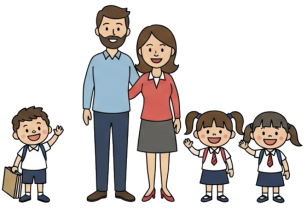
Question More, Action Knowledge.
Remember, at QMAK, we don’t just teach; we empower. We don’t just inform; we inspire. We don’t just question; we act. Become a Gold Member, and let’s unlock your child’s full potential, one question at a time.
Here you will find the resources that compliment the lessons taught during the month.
This beautifully illustrated biography tells the story of Wassily Kandinsky, one of the pioneers of abstract art, and how he experienced colors as sounds and sounds as colors. Through Kandinsky’s journey, children can learn about synesthesia, the blending of senses, and how this unique perspective influenced his groundbreaking artwork.
1. Who is the main subject of this book?
a) Pablo Picasso
b) Vincent van Gogh
c) Wassily Kandinsky
d) Claude Monet
2. What special ability did Kandinsky have?
a) He could fly
b) He could see colors when he heard music
c) He could talk to animals
d) He could predict the future
3. What did young Kandinsky’s family want him to become?
a) A painter
b) A musician
c) A lawyer
d) A doctor
4. What gift changed Kandinsky’s life?
a) A violin
b) A paintbox
c) A camera
d) A book
5. How did Kandinsky describe the colors when he first used the paintbox?
a) Quiet and dull
b) Noisy and alive
c) Smelly and weird
d) Tasty and sweet
6. What did Kandinsky’s early art teachers tell him to do?
a) Paint exactly what he saw
b) Use more bright colors
c) Quit painting
d) Paint faster
7. Why did Kandinsky eventually quit his job as a lawyer?
a) He was fired
b) He wanted to travel the world
c) He decided to become a full-time artist
d) He inherited a lot of money
8. What kind of art did Kandinsky create that was different from other artists?
a) Portraits
b) Landscapes
c) Still life
d) Abstract art
9. How did people initially react to Kandinsky’s abstract paintings?
a) They loved them immediately
b) They were confused and critical
c) They didn’t notice anything different
d) They offered to buy all his paintings
10. What is the main message of the book?
a) Always do what others tell you
b) Art is only for talented people
c) It’s important to follow your passion and unique vision
d) Abstract art is better than other forms of art
1. c) Wassily Kandinsky
2. b) He could see colors when he heard music
3. c) A lawyer
4. b) A paintbox
5. b) Noisy and alive
6. a) Paint exactly what he saw
7. c) He decided to become a full-time artist
8. d) Abstract art
9. b) They were confused and critical
10. c) It’s important to follow your passion and unique vision
Setting “The Abstract Art Adventure” to music creates a playful way for children to experience the world with fresh eyes, transforming mindful observation into a catchy artistic exploration. The song’s imagery of seeing “colors without names” gives children a simple tool for appreciating their surroundings beyond ordinary labels and meanings.
This melodic approach makes mindfulness feel like a creative adventure rather than a practice, providing children with a friendly tune they can recall whenever they want to discover beauty in everyday moments, helping them develop wonder and present-moment awareness through the natural appreciation that music inspires.
Verse 1:
Look around, what do you see?
Not things, but shapes so free
Swirls of green, dots of blue
A world of art, just for you
Pre-Chorus:
No need to name, no need to know
Just let the colors flow and grow
Chorus:
We’re on an Abstract Art Adventure
Seeing the world in a new measure
Patterns, textures, all around
A canvas where wonder is found
Verse 2:
Sidewalk cracks make crazy lines
Tree bark swirls with grand designs
Clouds paint stories in the sky
An artist’s dream passing by
(Pre-Chorus)
(Chorus)
Bridge:
Our eyes are brushes, painting scenes
Of what the world really means
Not objects separate and apart
But one big, beautiful work of art
(Chorus)
Outro:
Open your eyes to this abstract view
A masterpiece of me and you
In this world of colors without names
We’re all part of nature’s frames
While it might sound a little silly or even cheesy, songs are a great way to reinforce business lessons in a fun, memorable way—by tapping into musical and auditory learning styles, they help key concepts stick and support long-term retention in a way that traditional methods often can’t.
Verse 1:
Got an idea, oh so bright
Let’s make a model, test if it’s right
Clay or cardboard, whatever we’ve got
Bring that dream from your mind to this spot
Pre-Chorus:
It’s not perfect, that’s okay
We’re learning as we play
Chorus:
It’s a prototype parade
Watch our ideas come to life today
Try it out, ask our friends
Improve and try again
From simple starts to big dreams
Things aren’t always what they seem
In this prototype parade
Verse 2:
Super Sneakers light up the floor
Dance and music, oh what’s in store?
Draw it, build it, give it a go
Show your friends and watch it grow
(Pre-Chorus)
(Chorus)
Bridge:
Don’t worry if it’s not quite right
Each try brings your dream in sight
Be creative, have some fun
Your invention has just begun
(Chorus)
Outro:
Join the prototype parade
Where big ideas are made

Remember, at QMAK, we don’t just teach; we empower. We don’t just inform; we inspire. We don’t just question; we act. Become a Gold Member, and let’s unlock your child’s full potential, one question at a time.